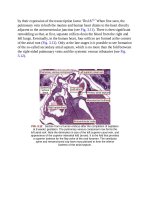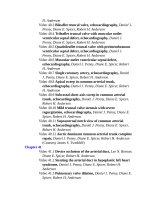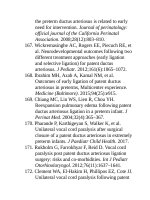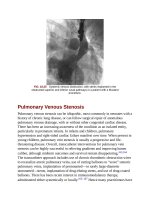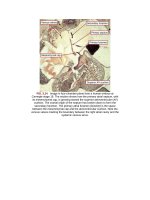Andersons pediatric cardiology 404
Bạn đang xem bản rút gọn của tài liệu. Xem và tải ngay bản đầy đủ của tài liệu tại đây (81.41 KB, 3 trang )
Abstract
Anunderstandingoftheanatomy,physiology,andalternativetreatment
strategiesforcongenitalheartdefectsisessentialtoprovidetheappropriate
patientcare.Thischapterreviewscurrentindicationsandbestpractice
guidelinesbyproceedingthroughthediagnosticcardiaccatheterization
procedurefrombeginningtoendintheorderofanatomicstructures
evaluated.
Keywords
CardiacCatheterization;PediatricandAdultCongenitalDiagnosis
Introduction
Anunderstandingoftheanatomy,physiology,andalternativetreatment
strategiesforcongenitalheartdefectsisessentialtoprovidetheappropriate
patientcare.Thisincludesanunderstandingoftheguidelinerecommendations
andthenaturalhistoryofcongenitalheartdefects.Thisknowledgeisrequiredto
determineifthereisanindicationfortreatmentoftheseconditions.Pediatricand
adultcongenitalheartpatientsofferdistinctchallenges,suchasunusual
cardiovascularanatomyandderangedorsurgicallycorrectedphysiology,andfor
olderpatientstherearedemandssuchaspregnancyandexercisetolerabilitynot
foundintraditionalpatients.
Diagnosticcardiaccatheterizationforchildrenwithheartdiseaseandadults
withcongenitalheartdiseaseisthepracticeofpercutaneouscatheter-based
techniquestoassesscardiovascularhemodynamicsandanatomy.Real-time
fluoroscopywithcontrastinjectioncoupledwithrapiddigitalangiography
provideshigh-resolutionimagesoftheheartthatarenecessaryforsuccessful
managementdecisions.Inaddition,thedirectmeasurementofpressureswithin
thecardiovascularsystemenhancesthetreatmentofheartdiseaseforthispatient
populationbystreamliningmedicaltreatmentoptionsanddefiningsurgicaland
interventionalindications.
Thischapterreviewscurrentindicationsandbestpracticeguidelinesby
proceedingthroughthediagnosticcardiaccatheterizationprocedurefrom
beginningtoendintheorderofanatomicstructuresevaluated.
HistoricalBackground
In1628thecourtphysiciantoJamesIandCharlesIofEngland,Dr.William
Harvey,presentedthe“movementoftheheartandblood”inanexperimentona
deer.Heusedhisexperimentsanddeductivelogictoconcludethatbloodwas
pumpedbytheheartthroughsystemicandpulmonarycirculations.These
experimentsconfirmedunidirectionalbloodflowinthebloodvessels.In1929
WernerForssmannofGermanydemonstratedonhimselftheabilitytomovea
urethralcatheterintohisbasilicveininhisleftarmtohisheart.Hethenwalked
toradiologyandmadeanx-raytoprovethecathetercourse.Afterthisreporthe
wasfiredbyhischiefofsurgerywhosaid“forarealsurgeon,thereisonlyone
thing,tooperate,tooperate,tooperate.”Ultimately,hewasawardedtheNobel
Prizein1956.
Overthenext6decades,thefieldofstructuralandcongenitalcardiac
catheterizationevolvedintoprimarilyaninterventionaldiscipline.1Accordingly,
diagnosticcardiaccatheterizationevolvedtomostlythepreintervention
evaluationandassessment.Meanwhile,thepurediagnosticcardiac
catheterizationregressedtoalimitedandselectpatientgroup.Currentlythe
diagnosticcardiaccatheterizationandpercutaneousinterventionalprocedures
arenotmutuallyexclusive.Itiscurrentlyrecommended2,3thatpercutaneous
interventionsareprecededbyadiagnosticevaluationthatmostoftendetermines
theindicationsforthatintervention(classI;levelofevidence:A).Consequently,
assessmentofpatienthemodynamicsand,whennecessary,assessmentof
anatomybyangiographyshouldbeaccomplishedbeforetheinterventional
cardiaccatheterizationtoconfirmcongenitaloracquiredheartdiseaseininfants
andchildren,aswellasadultswithcongenitalheartdefects.4
Ontheotherhand,mostpurediagnosticcardiaccatheterizationswilloften
includepreprocedurediscussionsregardingpotentialinterventionsifindications
foraninterventionalprocedurearemetduringthediagnosticevaluation.
Consequently,boththeproceduralpreapprovalprocessandtheinformedconsent
processformostdiagnosticcardiaccatheterizationsincludeconsentforany
possibleintervention.Thisisessentialinthemanagementofchildrenbuteven
moresoforolderchildrenandadultswhereassentandconsentfromthepatient
ismandatorypriortosedatives.Thispreparationwillallowcongenitalheart
patients,whohaveoftenalreadyundergonemultipleprocedures,toavoidmore
